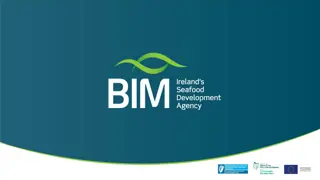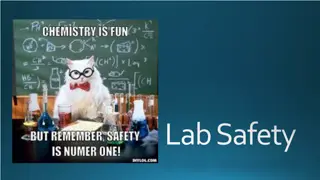Organic Lab Safety Rules - Chem 350/351
Chemical safety is paramount in the organic lab. Always wear splash-proof goggles, report injuries promptly, and know the locations of safety equipment. Submit pre-lab plans, work in fume hoods, wear gloves as instructed, and follow lab schedules. Unauthorized experiments and food/drink are prohibited. Always read chemical labels, wash hands/gloves after handling chemicals. Safety is key in the organic lab environment.
Uploaded on Oct 07, 2024 | 0 Views
Download Presentation

Please find below an Image/Link to download the presentation.
The content on the website is provided AS IS for your information and personal use only. It may not be sold, licensed, or shared on other websites without obtaining consent from the author.If you encounter any issues during the download, it is possible that the publisher has removed the file from their server.
You are allowed to download the files provided on this website for personal or commercial use, subject to the condition that they are used lawfully. All files are the property of their respective owners.
The content on the website is provided AS IS for your information and personal use only. It may not be sold, licensed, or shared on other websites without obtaining consent from the author.
E N D
Presentation Transcript
Organic Lab Safety Rules Chem 350/351 Prof T Nalli, WSU
Chemical splash-proof goggles must be worn AT ALL TIMES in the lab except during pre-lab lectures or when indicated by the instructor. Only indirect-vented goggles marked as Z87.1 are acceptable.
Report all injuries to your laboratory instructor or TA as soon as possible.
Know the locations and proper use of the: fire extinguisher safety shower eyewash station.
Be prepared for your work. A pre-lab plan must be submitted before beginning work on any lab experiment.
All work is to be carried out in a fume hood. Keep all chemicals in your hood whenever possible. Rinse glassware to be cleaned preliminarily with acetone in the dispensing hood before bringing to the sinks for washing.
Gloves must be worn when instructed to do so.
No work is permitted outside of the scheduled lab periods unless you have been given permission.
Unauthorized experiments are not allowed.
Read the labels on chemicals to be used very carefully.
Wash your hands and gloves with soap and water after using chemicals and again before leaving lab.
Coats should be left on the hooks provided inside the lab and bags should be placed out of the way.
Chemical wastes should be disposed of properly.
Disposable/broken glassware should be placed in the glassware container (the 5-gallon tub near the doorway).
Clean up broken glassware using the broom and dustpan. Never pick up a piece of broken glass with your hands.
Dress appropriately: Hair must be pulled back away from the face. Clothing must completely cover legs. Leggings or other items of tight clothing are not permitted. Shoes must completely cover the foot. No sandals are allowed. Contact lens wearers should be aware of potential risks. Tight jewelry, such as finger rings, which cannot be easily removed, should not be worn.
When wearing gloves, treat the gloves as you would your hands. Wash them frequently with soap and water.
Clean up all spills, including water, immediately. Ask the instructor or TA for help cleaning up chemical spills.
For acid/base spills: Neutralize acid with sodium bicarbonate or base with boric acid then sponge up with plenty of water.
Do not insert pipettes or medicine droppers into reagent bottles.
Do not return unused chemicals to their bottles. Dispose of them in properly labeled waste containers.
Make sure spatulas are clean and dry before using them to remove solid chemicals from reagent bottles.
When preparing diluted acid solutions, always pour the acid into the water.
If you are exposed to a chemical: Eyes use eye wash for at least 15 minutes Skin flush immediately with cold water for 10-15 minutes Clothing use safety shower, remove affected clothing. Inhalation go outside and breathe fresh air for 10 minutes.
All incidents involving chemical exposure will be documented by the lab instructor and/or campus security. Anyone needing to use the eyewash or safety shower will be required to seek follow-up medical attention.
Should an accident in the lab involve human blood or other potentially infectious materials, please keep in mind: If you are bleeding, you must notify your lab instructor and/or TA. Fellow students in lab should avoid assisting in situations involving potentially infectious materials- the potential for others to be exposed to potentially infectious materials must be limited. Campus security is always available to assist if the situation warrants. If you are able, you will be asked to clean up any contaminated area involved. Again, this is to reduce the potential of others being exposed to potentially infectious materials. If you need assistance, security will be called. Be aware that they will put on gloves to protect themselves and you-please do not take this personally! Any area contaminated with potentially infectious materials has to be properly disinfected and all materials used to clean up the area have to be disposed of as infectious waste. No infectious waste can go into the regular trash.
As a general rule: Use common sense- if you are not sure about procedures, chemicals, etc., then ask the instructor! Please help keep our labs safe- if you observe any potential hazards, notify somebody.
If you are pregnant, contact your health care provider about possible risks associated with the chemicals used in the lab. You may wish to inform your lab instructor. Your instructor may inform you about possible alternative accommodations.
In the case of an emergency, it is important to act quickly and cautiously. In doing so, it is important to be fully aware of any pre-existing conditions or circumstances that may affect treatment. In addition, other health conditions, such as prescription allergies or seizures, may exist that would make it difficult to administer proper emergency treatment. If such a case were to occur, it is important that the lab instructor be aware of such conditions. The disclosure of any special circumstances/conditions that you may have is completely voluntary. However, if you would like to make the instructor aware of any of these situations, please indicate those that should be taken into consideration in an emergency.
You are responsible for proper disposal of the infectious or biohazardous wastes you handle. Always put the wastes in the designated and labeled infectious / biohazardous waste containers. Your instructor will show you the proper location in the laboratory or classroom for each type of waste generated. Never dispose of hazardous waste using sinks or intentional evaporation or as regular trash. It is harmful for the environment and against the law. All campus laboratories and classrooms must abide by strict Minnesota Pollution Control Agency and federal Environmental Protection Agency waste disposal requirements. You may be held liable for violations of applicable laws. Remember: Simply because a waste is nonhazardous does not mean that it can go into a dumpster or in a drain. Other regulations may apply. Ask your instructor. Examples of infectious or biohazardous waste: Blood and blood products, other regulated body fluids, items dripping with body fluids, sharps (e.g. syringe needles) What happens to the waste after it is put in the labeled waste container? Your classroom has containers specifically labeled for infectious / biohazardous waste. After the wastes are collected from the classroom, they are decontaminated, either by campus personnel or a contracted service provider. Eventually, they are disposed by an authorized and licensed waste disposal facility.
You are responsible to properly handle the chemical wastes you generate: Always put the wastes in the designated and labeled hazardous waste containers. Your instructor will show you the proper location in the laboratory or classroom for each type of waste generated. Never mix one type of waste with another. Never dispose of hazardous waste using sinks, intentional evaporation, or as regular trash. Those are harmful for the environment and against the law. All campus laboratories and classrooms must abide by strict Minnesota Pollution Control Agency and federal Environmental Protection Agency waste disposal requirements. You may be held liable for violations of applicable laws. Immediately report any spills to the instructor. Remember, simply because a waste is nonhazardous does not mean it may go into a dumpster or a drain. Other regulations may apply. Ask your instructor. Hazardous waste includes many types of materials. They are categorized by state and federal laws. The categories are referred to as lists. Examples that may be found in a chemistry lab include: Distillation residues, solvents, aqueous acid/base solutions, reaction products and side products, spent drying agents, unneeded reactants. What hazardous wastes will I come in contact with in my academic program? Your instructor will discuss specific hazardous wastes you may encounter in your class. Each type of hazardous waste is separately stored in a special container designed for that waste. Your classroom has containers for types of wastes you will generate in your academic program. What happens to the waste after it is put in the labeled waste containers? From the classroom, the hazardous wastes typically are transferred to a holding spot on campus such as the satellite accumulation center or central disposal storage location . Eventually, an authorized and licensed waste disposal facility will dispose of the waste. Each waste is separately disposed of in a way that prevents it from polluting the air, water and land.























